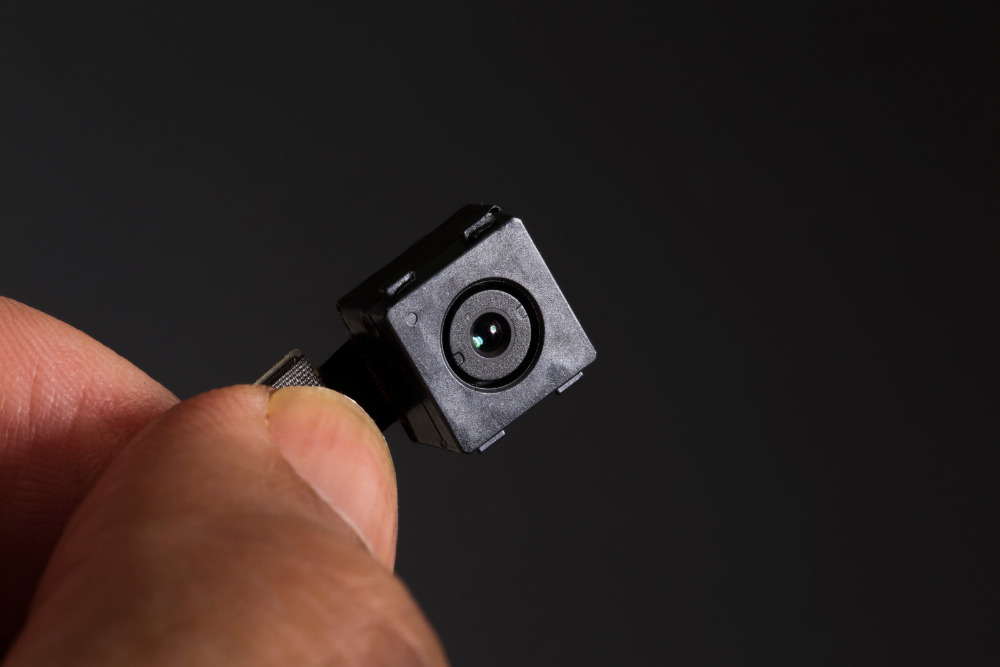How to Check for Hidden Cameras

Are you being watched? The idea of home invaders is terrifying, yet one of the most frightening crimes is when someone invades your sense of privacy. With the advent of advanced technology, spy cams—tiny, near-invisible cameras that track unsuspecting people—have become more prevalent, particularly in short- and long-term rental properties. What can you do to protect yourself? Here are popular spy cam hiding places and how to check for hidden cameras.
Who Should Look for Spy Cams?
How do you know that you even need to look for hidden cameras?
The people who are most at risk are those who are moving into a rental property or staying at a short-term private residence (like an Airbnb). Because someone else owns the space and has unfettered access to it, it’s easy for the owner to set up hardware before you arrive. If you ever occupy a rental property, even just for a quick trip, it’s wise to check for cameras. Better to be safe than sorry.
Also, use caution if you’ve had an unknown third party in your living space for maintenance or contract work, especially involving powered interior devices like smoke alarms. This is another opportunity when your home is vulnerable and someone can easily install surveillance equipment without your knowledge. If you’re having repairs done, have the technicians explain the work they did in detail and check the brand names of any new devices online.
If you routinely enter someone else’s private property for work (nannying, cleaning, repairs, etc.), be aware that they may have cameras in their home. They may or may not choose to tell you about these cameras. Similarly, you can assume any store or business you visit probably has cameras, even if you can’t see them. This is completely legal as long as the cameras aren’t in bathrooms or other areas where you’d reasonably expect privacy.
In the vast majority of cases, you can trust rental property owners, contractors, employers, and business owners. However, there are always exceptions, and a little due caution never hurts. If you think you may be the victim of spying, there are a couple of quick checks you can do to spot a hidden camera.
What Do Hidden Cameras Look Like?
Picture how small the camera on a smartphone can be. That should give you a pretty good picture of how small any camera can be. Often, all that you can see is a lens. And these can be small enough to hide in the head of a screw.
Older models typically connect by wires to a battery or outlet and transmit via radio frequencies. Modern versions use Wi-Fi to transmit signals and don’t necessarily require wires. Because they’re so small, they can fit into the body of other devices to hide the camera body and any wires or hardware.
In other words, you might see the cameras themselves, or you might not. But either way, there are ever-evolving tricks to hide them. That’s why knowing how to check for hidden cameras is so important.
How to Check for Hidden Cameras
Most modern hidden cameras use Wi-Fi to transmit video. As such, one of the easiest ways to detect a hidden camera is to use software that reveals all the devices connected to a network. Use an app like WiFi Guard for Apple products or WiFi Monitor for Android. However, this method is not entirely reliable. Some possible issues? Many devices can hide from this sort of search, you may not have administrator access to your network, or the cameras might use radio wave transmission, which would bypass the network.
There are products on the market that can detect hidden devices, but if you’re going to pay for equipment, it might just be time to hire a professional. Many personal investigators routinely conduct bug sweeps as part of their available services.
Your best free option is to think like a voyeur and look for devices in logical hiding spots. Look for a small lens, a pinhole, or anything else that looks out of sorts. You can also try grabbing a flashlight and turning off all the lights in the room Many cameras have a small light that lets the user know the camera is on and filming. Those that don’t have this still have a lens that will reflect the light from a flashlight. So even if the device is in a vent or grating, you’ll see a light shine back at you.
Common Hiding Places
Hidden cameras are useless if they can’t see. When you’re trying to find them, remember that they need a good view of the room. Be aware of strange decorations or devices in corners, especially on high shelves. A corner provides an ideal angle for capturing most of the room. Also, be wary of large glass mirrors, particularly those that are wall-mounted, as they may be two-way glass. Anything hanging in the middle of the room also offers a good view and rests in a place that most people can’t (or won’t) disturb.
But of course, most hidden cameras are hidden inside or behind something else. So what are some of the most common dummy items?
Check These Items to Find Hidden Cameras
The market for hidden cameras is always evolving, thanks in part to advancements in electronics. The most convenient way to hide a camera is to include it in an electronic device that is already plugged into the wall. With this in mind, here are some common household items that can house a hidden camera:
- Smoke or CO detectors: Because detectors are centrally located and occupants rarely interact with them, they’re among the most common hiding spots.
- USB chargers, phone chargers, and outlets: These already have a continuous power source and benign wires, so incorporating a camera is simple work.
- Lightbulbs and fans: Similarly, these have an easily accessible power source. They also occupy prime viewing spots away from suspecting eyes.
- House plants: Though it doesn’t involve other electronics, a potted plant is a tried-and-true way to camouflage many things, including cameras.
- Stuffed animals: These were originally the standard spot for nanny cams, although this trend has died down a bit.
- Bluetooth speakers
- Clocks
- Plug-in devices like air fresheners and night lights
There are a few other items you might not suspect that warrant special attention: two-way mirrors and screws.
Two-Way Mirrors
One of the many ways to hide a camera is behind a two-way mirror. This is a trick sometimes found in bathrooms or changing areas. (Needless to say, that’s not somewhere most people want to be caught on camera.) There are a few ways to check if a mirror is actually two-way glass.
- The first way to check if you’re being watched is to tap the glass. If the mirror is metal, like those commonly used in gas station bathrooms, it can’t be a two-way mirror. If it’s glass, pay attention to the sound. A two-way mirror should give off a sharp ping noise, while a standard mirror will give a duller thud.
- Check your surroundings. Is the mirror in a strange place or hung oddly? Does the layout of the building seem strange, like there could be an extra room behind the mirror?
- Another giveaway is the brightness of the room. In order to see through a two-way mirror, the light must be brighter on the mirrored side. If the lights in the room are much brighter than you’d expect them to be, this might mean something is afoot.
- If you’re still unsure, try the fingernail test. Place your fingernail against the mirror. With a standard mirror, there should be a small gap between your fingernail and its reflection. With a two-way mirror, there will be no gap.
Two-way glass makes it very hard to detect a camera. But if you discover a two-way mirror, it’s safe to say that your privacy is at risk.
Screw-Mounted Cameras
Don’t underestimate how tiny cameras can be. It’s possible that a camera could be so small that it can be mounted on the head of a screw or nail. If this is the case, the lens of the camera will still reflect light. Shine a light on the suspicious screw. Does the light shine back? If it does, it may have a hidden camera on it. You might find a camera like this on a wall hook or shelf.
How Your Phone Can Help
If you suspect someone of planting a hidden camera and these tips haven’t helped, try using your phone’s front camera and screen to look for infrared light. While the back camera will have an infrared light filter, the front camera won’t. Turn off the lights in the room and use the front camera to scan the room. If any suspicious lights appear on the screen, investigate those areas in more detail.
What to Do If You Find Hidden Cameras
Now that you know how to check for hidden cameras, you’re probably wondering what to do when you locate one. If you should find a camera in a suspicious location, take a picture of any hardware, leave the area, and report it to the authorities. Don’t disable the camera yourself. After all, the police might want to look for fingerprints, and you don’t want to get in trouble for damaging someone else’s property.
Hiding cameras in places where a person should expect privacy is illegal. While businesses and homeowners do have a right to record inside their properties, residents and guests have the right to a reasonable expectation of privacy. (Brush up on security camera laws if you’re unsure.)
What About Deep Sentinel?
Deep Sentinel’s guards monitor your home security cameras any time there is suspicious activity outside your home. To protect your privacy and the privacy of your visitors, Deep Sentinel cameras are not permitted inside residential properties. If someone sets up a camera where it shouldn’t be, the guards will disable it and inform the homeowner about the issue. You never need to worry about how to check for hidden cameras with Deep Sentinel. No one can use a hidden Deep Sentinel camera to spy on you in their home.
(Besides, with live security guards that intervene and scare off criminals at the first sign of trouble, Deep Sentinel cameras are hardly meant to be secretive!)
Need a Solution that Prevents Crime?
Deep Sentinel is the only security technology that delivers the experience of a personal guard on every customer’s home and business. Visit deepsentinel.com or call 833-983-6006

